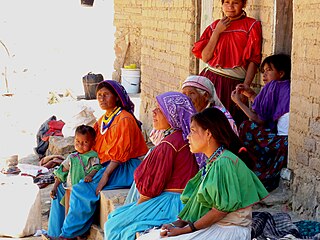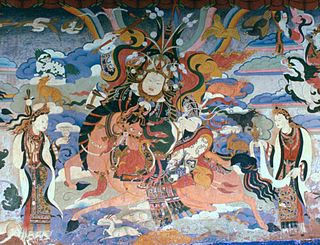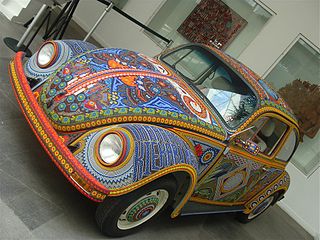
Shamanism or samanism is a religious practice that involves a practitioner interacting with the spirit world through altered states of consciousness, such as trance. The goal of this is usually to direct spirits or spiritual energies into the physical world for the purpose of healing, divination, or to aid human beings in some other way.

Carlos Castañeda was an American writer. Starting in 1968, Castaneda published a series of books that describe a training in shamanism that he received under the tutelage of a Yaqui "Man of Knowledge" named don Juan Matus. While Castaneda's work was accepted as factual by many when the books were first published, the training he described is now generally considered to be fictional.

Shaman King is a Japanese manga series written and illustrated by Hiroyuki Takei. It follows the adventures of Yoh Asakura as he attempts to hone his shaman skills to become the Shaman King by winning the Shaman Fight. Takei chose shamanism as the main theme of the series because he wanted a topic that had never been attempted before in manga. The Shaman King manga was originally serialized in Shueisha's Weekly Shōnen Jump between June 1998 and August 2004. The individual chapters were collected and released in 32 tankōbon volumes. In 2017, Kodansha acquired the rights to the series and re-launched it on 35 e-book volumes in 2018, also published in print since 2020.

A witch doctor was originally a type of healer who treated ailments believed to be caused by witchcraft. The term is now more commonly used to refer to healers, particularly in regions which use traditional healing rather than contemporary medicine.

The Huichol or Wixárika are an indigenous people of Mexico and the United States living in the Sierra Madre Occidental range in the states of Nayarit, Jalisco, Zacatecas, and Durango, as well as in the United States in the states of California, Arizona, New Mexico, and Texas. They are best known to the larger world as the Huichol, although they refer to themselves as Wixáritari in their native Huichol language. The adjectival form of Wixáritari and name for their own language is Wixárika.
Neoshamanism refers to new forms of shamanism. It usually means shamanism practiced by Western people as a type of New Age spirituality, without a connection to traditional shamanic societies. It is sometimes also used for modern shamanic rituals and practices which, although they have some connection to the traditional societies in which they originated, have been adapted somehow to modern circumstances. This can include "shamanic" rituals performed as an exhibition, either on stage or for shamanic tourism, as well as modern derivations of traditional systems that incorporate new technology and worldviews.

Wirikuta is a desert, sacred to the Wixárika (Huichol) people high in the mountains of central Mexico, between the Sierra Madre Oriental and the Zacatecas ranges, near Real de Catorce. In Wixárika cosmology, the world is believed to have been created in Wirikuta.

Barbara Myerhoff was an American anthropologist, filmmaker, and founder of the Center for Visual Anthropology at the University of Southern California. Throughout her career as an anthropologist, Barbara Myerhoff contributed to major methodological trends which have since become standards of social cultural anthropology. These methods include reflexivity, narrative story telling, and anthropologists' positioning as social activists, commentaries, and critics whose work extends beyond the academy.

Tengrism is a religion originating in the Eurasian steppes, based on shamanism and animism. It generally involves the titular sky god Tengri, who is not considered a deity in the usual sense but a personification of the universe. According to some scholars, adherents of Tengrism view the purpose of life to be in harmony with the universe.
The Huichol language is an indigenous language of Mexico which belongs to the Uto-Aztecan language family. It is spoken by the ethnic group widely known as the Huichol, whose mountainous territory extends over portions of the Mexican states of Jalisco, San Luis Potosí, Nayarit, Zacatecas, and Durango, mostly in Jalisco. United States: La Habra, California; Houston, Texas. Under the 2003 Law on Indigenous Language Rights, the indigenous languages of Mexico along with Spanish are recognized as "national languages".

A God's eye is a spiritual and votive object made by weaving a design out of yarn upon a wooden cross. Often several colors are used. They are commonly found in Mexican, Peruvian, and Latin American communities, among both Indigenous and Catholic peoples.

The Mongol mythology is the traditional religion of the Mongols.
The Tungusic creation myths are traditional stories of the creation of the world belonging to the Tungusic peoples of Siberia.

Nicolás Echevarría is a Mexican film director and cinematographer. He has directed over 20 films since 1973. His 1991 film Cabeza de Vaca was entered into the 41st Berlin International Film Festival.

The Vochol is a Volkswagen (VW) Beetle that has been decorated with traditional Huichol (Wirrárika) beadwork from the center-west of Mexico. The name created by José Jaime Volochinsky is a combination of "vocho", a popular term for VW Beetles in Mexico, and "Huichol", the common name of the Wirrárika indigenous group. The project was sponsored by agencies associated with the Museo de Arte Popular, Mexico City, the states of Jalisco and Nayarit and other public and private organizations. The Volkswagen was covered in 2,277,000 beads applied by eight artisans from two Huichol families in an exclusive design based on Huichol culture.

Huichol art broadly groups the most traditional and most recent innovations in the folk art and handcrafts produced by the Huichol people, who live in the states of Jalisco, Durango, Zacatecas and Nayarit in Mexico. The unifying factor of the work is the colorful decoration using symbols and designs which date back centuries. The most common and commercially successful products are "yarn paintings" and objects decorated with small commercially produced beads. Yarn paintings consist of commercial yarn pressed into boards coated with wax and resin and are derived from a ceremonial tablet called a neirika. The Huichol have a long history of beading, making the beads from clay, shells, corals, seeds and more and using them to make jewelry and to decorate bowls and other items. The "modern" beadwork usually consists of masks and wood sculptures covered in small, brightly colored commercial beads fastened with wax and resin.

Earth, Air, Fire, and Water is an accessory for the 2nd edition of the Advanced Dungeons & Dragons fantasy role-playing game, published in 1993.

Santos Motoapohua de la Torre is one of the most world renowned Huichol artists. His works aims to capture the mystery and magnificence of Wixárika's cosmogony and his main works are located in places like Paris, Chicago, Zacatecas and Nayarit. The meaning of his Huichol name, "Motoapohua", is "Echo of the mountain".













